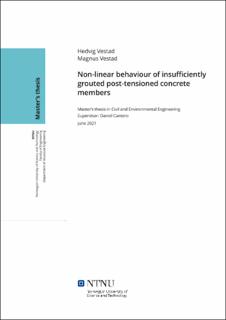| dc.description.abstract | The purpose of this master thesis was to investigate the structural effects of insufficiently grouted post tensioned concrete members. This was carried out by performing non¬linear analyses in the Finite element analysis program DIANA10. The thesis is divided into two main parts. Part I was based on the recreation of experiments to gain a greater knowledge of the program. The modelled experiments were four¬point bending tests performed on one ordinary reinforced beam and two post¬tensioned beams. By comparing the numerical results to the experiments, it could be confirmed that the modelling and iterative analyses were correctly performed and could be used in the further work. One of the post¬tensioned beam models was used to investigate how insufficient grouting can be modeled in DIANA by using a concept called ”bond¬slip reinforcements”. This concept allows the user to model the tendon discretely with interface elements. By adjusting the normal and shear stiffness of these elements, the level of bonding could be defined. To find appropriate values for the stiffnesses of these elements, a parametric study was performed. The study demonstrated that the choice of stiffnesses had a great impact on the loss of prestress in the tendon. In Part II of the thesis, the research question was connected to real structures. This was done by modelling a generic span of a post¬tensioned beam bridge, inspired by the bridge Rossvollbrua. ”Håndbok R412 ¬ Bruklassifisering” was used to calculate the relevant traffic loads. A new parametric study of the stiffness parameters on the tendon interfaces was performed, as these parameters proved to depend greatly on the element size and geometry of the tendon. Finally, a non¬linear analysis was performed on the bridge model. The results from the beam models and the bridge model showed the same tendencies. The difference between the behaviour of a completely grouted tendon and a tendon without any grouting was small. Until the point of cracking, the two models had the same linear behaviour. For the non¬linear part of the load-deformation curves, the ungrouted model had a slightly lower capacity, giving a 7,6 % reduction of ultimate load capacity for the beam models and a 1,8 % lower capacity for the bridge model. The crack pattern when comparing the two cases were very similar, but the results suggest that the cracks of an ungrouted concrete member are concentrated in groups, contrary to the more evenly distributed cracks of a grouted concrete member. | en_US |

